Lincoln Cathedral
Lincoln, Lincolnshire
|

Location Guide |
| For over 200 years from
1300 to 1549 it was the tallest building in the world, but the central
spire collapsed and was not rebuilt. Today its Britain's third largest
cathedral. Earlier cathedrals on
this site have been destroyed by fire and an earthquake. Towers
collapsed or blown down by wind.
Image by
Chris McKenna


Click
any smaller image to sea a larger one |
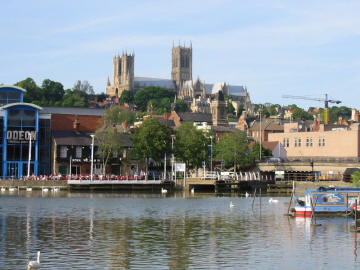 |
Its full name is The Cathedral Church of the
Blessed Virgin Mary of Lincoln, or sometimes St. Mary's Cathedral
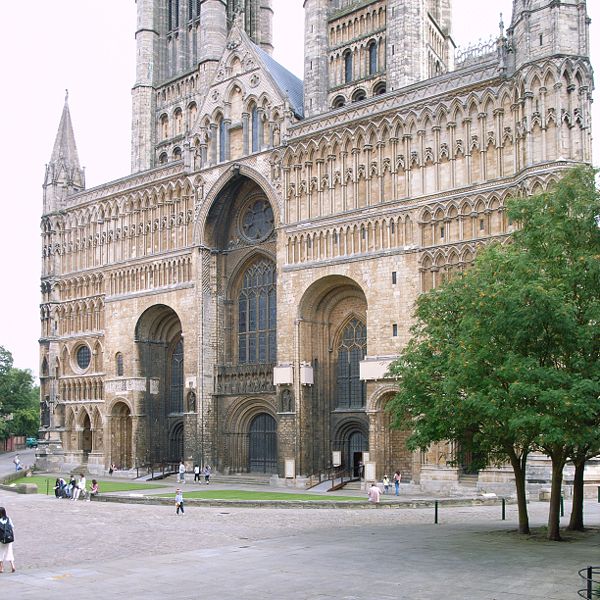
Picture by
Steve Cadman

History
William the Conqueror ordered the first
cathedral to be built in Lincoln, in 1072. Before that, St. Mary's Church in
Lincoln was a mother church but not a cathedral, and the seat of the diocese was
at Dorchester Abbey in
Dorchester-on-Thames, Oxfordshire. Lincoln was more central to a diocese
that stretched from the Thames to the Humber. Bishop Remigius built the first
Lincoln Cathedral on the present site, finishing it in 1092 and then dying two
days before it was to be consecrated on May 9 of that year.
| About fifty years later, most of that
building was destroyed in a fire. Bishop Alexander rebuilt and expanded
the cathedral. It was destroyed
by an earthquake about forty years later, in 1185. After the earthquake,
a new bishop was appointed. The new bishop was St Hugh of Lincoln,
originally from Avalon, France, he began a massive rebuilding and
expansion programme. Rebuilding began at the east end of the cathedral,
with an apse and five small radiating chapels. The central nave was then
built in the Early English Gothic style. Lincoln Cathedral soon followed
other architectural advances of the time - pointed arches, flying
buttresses and ribbed vaulting were added to the cathedral. This allowed
the creation and support of larger windows.
The cathedral is the 3rd largest in Britain (in floor space) after St
Paul's and York Minster, being 484ft by 271ft. It is Lincolnshire's
largest building and until 1549 the tower was the tallest medieval tower
in Europe. Accompanying the cathedral's large bell, Great Tom of
Lincoln, is a quarter-hour striking clock. The clock was installed in
the early 19th century.
Click
on smaller images to see larger versions |
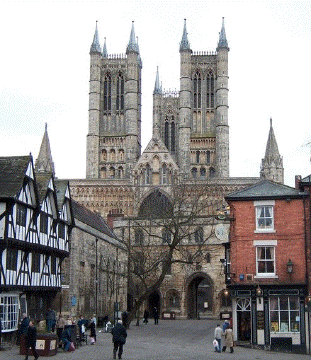
Image from Wikipedia
 |
In either in 1237 or 1239 the main tower
collapsed. A new tower was soon started and in 1255 the Cathedral petitioned
Henry III to allow them to take down part of the town wall to enlarge and expand
the Cathedral, including the rebuilding of the central tower and spire. They
replaced the small rounded chapels (built at the time of St Hugh) with a larger
east end to the cathedral. This was to handle the increasing number of pilgrims
to the Cathedral, who came to worship at the shrine of Hugh of Lincoln. Between
the years 1307 and 1311 the central tower was raised to its present height of 83m (271 feet). The western towers and front of the cathedral were also improved
and heightened.
| At this time, a tall
lead-encased wooden spire topped the central tower but was blown down in
a storm in 1549. With its spire, the tower reputedly reached a height of
525 feet (which would have made it the world's tallest structure,
surpassing the Great Pyramid of Giza, which held the record for almost
4,000 years). Other additions to the cathedral at this time included its
elaborate carved screen and the 14th century misericords, as was the
Angel choir. For a large part of the length of the cathedral, the walls
have arches in relief with a second layer in front giving the illusion
of a passageway along the wall. However the illusion does not work, as
the stonemason, copying techniques from France, did not make the arches
the correct length needed for the illusion effect. |
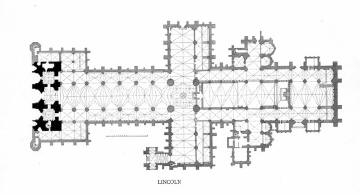
Plan of cathedral, click on the plan
to see a
larger version |
In 1290 Eleanor of Castile died. As his Queen
Consort of England, King Edward I decided to honour her with an elegant funeral
procession. After embalming, which in the thirteenth century involved
evisceration (organ removal), Eleanor's viscera were buried in Lincoln Cathedral,
and Edward placed a duplicate of the Westminster tomb there. The Lincoln tomb's
original stone chest survives, its effigy was destroyed in the 17th century and
replaced with a 19th-century copy. On the outside of Lincoln Cathedral are two
prominent statues often identified as Edward and Eleanor, but these images were
heavily restored in the 19th century and probably were not originally intended
to depict the couple.
Magna Carta
The Bishop of Lincoln was one of the
signatories to the Magna Carta and for hundreds of years the Cathedral has held
one of the four remaining copies of the original. It now resides in the nearby
Lincoln Castle, where it is on permanent display. There are three other
surviving copies, two at the British Library and one at
Salisbury Cathedral.

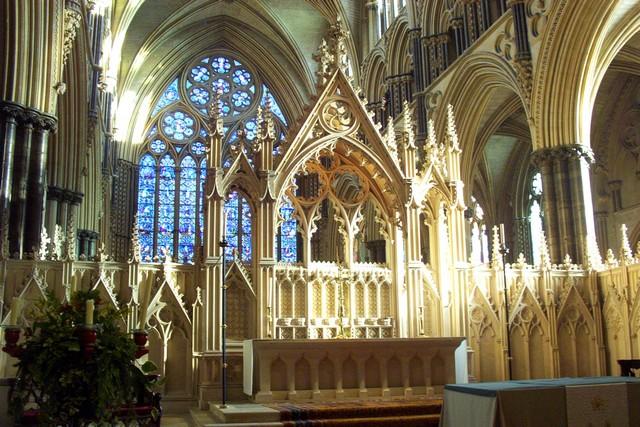
Image from Wikipedia

Although this cathedral can be
seen from some distance the best view of it is from the air, take a look at the
Multimap
 3D
birds eye view, one of the best views I have seen. 4 views to see all sides. 3D
birds eye view, one of the best views I have seen. 4 views to see all sides.
|
Location: Lincoln Cathedral, Lincoln |
|
Grid Reference:
SK978717 |
Ceremonial County:
Lincolnshire |
|
Map Link:
Multimap

|
Aerial photo:
Multimap

Multimap
 3D
birds eye view, one of the best views I have seen. 4 views to see all sides. 3D
birds eye view, one of the best views I have seen. 4 views to see all sides. |
|
Getting there: |
|
Access: |
Website:
Own, you can click on a link lower right of website to get out of the flash
system to a normal system.
you can click on a link lower right of website to get out of the flash
system to a normal system. |
Other Useful Websites:
wiki
 |
Email: visitors@lincolncathedral.com
 |
|
Address: The Chapter Clerk, 4 Priorygate,
Lincoln |
|
Postcode: LN2 1PL |
Telephone: 01522 561600 |
|
Opening Times:
Summer
Weekdays 7.15 am - 8.00 pm and Saturdays and Sundays 7.15 am - 6.00 pm
Medieval and Wren libraries during the summer months
Winter
Weekdays and Saturdays 7.15 am - 6.00 pm and Sundays 7.15 am - 5.00 pm |
|
Charges: Adults £4.00, Children (5 -16) £1.00.
Children under 5 Free. Concessions £3.00
Photography for own use free, otherwise check
for permission/cost. |
|
Nearby Locations: Roman remains, Norman
castle |
|
Other Location Pages:
List of all Anglican
cathedrals and other major Anglican churches in the UK

Abbey
section,
 including all major Christian buildings, regions orders, normal layouts and
history.
including all major Christian buildings, regions orders, normal layouts and
history. |
|
Notes:
No restrictions on photography are specified,
it says that photography for your own use is free.
|
|
Page Ref: Lincoln_Cathedral |
Classification: Abbeys (incl. all Christian buildings) |
Date Updated: 09/2008 |
|

|
Please let us know any other information that we
can add to the Further information and Planning Grids or page and any errors that you discover. Before making a long trip to any location it is always
wise to double check the current information, websites like magazines may be
correct at the time the information is written, but things change and it is of
course impossible to double check all entries on a regular basis. If you have
any good photographs that you feel would improve the illustration of this page
then please let us have copies. In referring to this page it is helpful if you
quote the Page Ref and classification at the bottom of the Planning Grid above. To print the
planning grid select it then right click and print the selected area.
Please submit information on locations you discover so
that this system continues to grow.
|